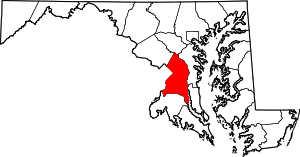Palmer Park, Maryland
| Palmer Park, Maryland | |
|---|---|
| Unincorporated community | |
 Palmer Park Location within the state of Maryland | |
| Coordinates: 38°55′15″N 76°52′18″W / 38.92083°N 76.87167°WCoordinates: 38°55′15″N 76°52′18″W / 38.92083°N 76.87167°W | |
| Country |
|
| State |
|
| County |
|
| Time zone | Eastern (EST) (UTC-5) |
| • Summer (DST) | EDT (UTC-4) |
| GNIS feature ID | 597865 |
Palmer Park is an unincorporated community in Prince George's County, Maryland, United States, within the census-designated place of Landover.[1] Palmer Park is served by the Landover Metro Station (orange line), which is northwest of Palmer Park across Landover Road.
Comedian Martin Lawrence once lived in Palmer Park while attending Eleanor Roosevelt High School in nearby Greenbelt. Palmer Park was the hometown of 1976 Olympics gold medal winning boxer Sugar Ray Leonard.
Palmer Park is home to the Palmer Park Senior Housing, Prince George's County Police Headquarters (District III), and is located right across from Prince George's Sports and Learning Complex and FedExField, home of the three-time Super Bowl champion Washington Redskins. Palmer Park is surrounded by four local schools: William Paca Elementary School, Kenmoor Elementary, Kenmoor Middle School, and Mathew Henson Elementary. The neighborhood high schools are DuVal Senior School and Charles Herbert Flowers Senior High School.
Right at the heart of Palmer Park are small stores that include a mini mart, gas station, hair salon, Boys and Girls Club offices, and a doctors office. In addition to the stores, Palmer Park Community Center is located right across the street.
Palmer Park is home to the Palmer Park Tigers, and holds an annual Palmer Park day in order to promote community spirit.
Palmer Park was adjacent to Wilson Dairy Farm. FedEx Field is now located on what used to be the Wilson dairy farm in the 1950s and '60s. Palmer Park was an enclave of post-WWII triplex housing units designed as starter homes for young low-income families (less than $13K). It is surrounded by three parks. It was predominantly white (99%) until segregation ended and blockbusting began in the 1960s. Within approximately two years, the community went from predominantly white predominantly black. A lawsuit was filed for blockbusting and was won by the former residents in the late 1960s. Despite its colorful history, it has been home to successful politicians, athletes, and artists and offers young people (very young average age for residents) the chance to rise to the opportunities and challenges of the DC metro area.[2]
| Historical population | |||
|---|---|---|---|
| Census | Pop. | %± | |
| 1970 | 8,172 | — | |
| 1980 | 7,986 | −2.3% | |
| 1990 | 7,019 | −12.1% | |
| source:[3][4] | |||
See also
References
- ↑ U.S. Geological Survey Geographic Names Information System: Palmer Park, Maryland
- ↑ http://www.point2homes.com/US/Neighborhood/MD/Landover-Demographics.html#Crime
- ↑ "CENSUS OF POPULATION AND HOUSING (1790-2000)". U.S. Census Bureau. Retrieved 2010-07-17.
- ↑ Not enumerated separately in 2000. Merged with Dodge Park, Landover and Kentland to form Greater Landover, renamed Landover for 2010 census.
